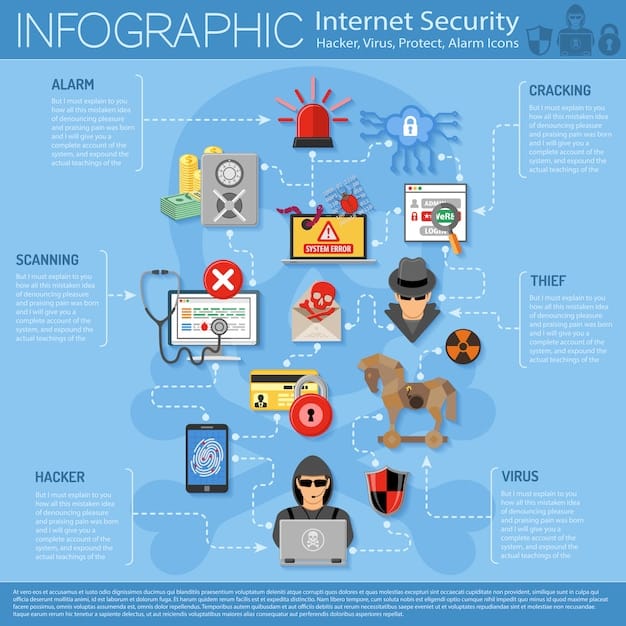Insider Threats: Detection and Prevention Strategies for US Businesses

Insider threats, whether stemming from negligence or malicious intent of employees, pose significant risks to data security; effective detection and preventive measures are crucial for protecting sensitive information.
The rise of cyber threats has made securing data more critical than ever. But, often overlooked, is the danger lurking within organizations: insider threats: detecting and preventing data breaches caused by negligent or malicious employees can save a company from immense harm.
Understanding the Landscape of Insider Threats
An insider threat is a security risk originating from within an organization. These threats can be unintentional, such as an employee accidentally exposing data, or malicious, like a disgruntled worker intentionally stealing sensitive information. Recognizing the different types of insider threats is crucial for developing effective security strategies.
Types of Insider Threats
Insider threats can be broadly categorized into negligent, compromised, and malicious insiders. Each type requires a different approach to detection and prevention.
- Negligent Insiders: These individuals unintentionally cause breaches due to carelessness or lack of awareness.
- Compromised Insiders: Their accounts are hijacked by external attackers.
- Malicious Insiders: These individuals intentionally steal or damage data for personal gain or revenge.
The Impact of Insider Threats
The consequences of insider threats can be devastating. Data breaches can lead to financial losses, reputational damage, and legal liabilities. Understanding these potential impacts can help justify investments in insider threat prevention measures.
Insider threats can be difficult to detect. Unlike external attacks, insider threats exploit legitimate access to systems and data, making them harder to spot. Organizations must implement a multi-layered security approach that includes monitoring user behavior, controlling access to sensitive information, and training employees to recognize and report suspicious activity. By addressing these challenges, organizations can effectively mitigate the risk of insider threats and protect their valuable assets.

Detecting Insider Threats: Key Indicators and Techniques
Detecting insider threats involves monitoring employee behavior and identifying anomalies that could indicate malicious activity. Several techniques can be employed to identify suspicious activity early on.
Behavioral Analytics
Behavioral analytics involves monitoring employee behavior patterns to identify deviations from the norm. This can include analyzing access patterns, file usage, and communication patterns.
Access Control Monitoring
Monitoring access control logs can help identify unauthorized access attempts or unusual activity. This includes tracking who is accessing what data, when, and from where.
- Implement Least Privilege: Grant employees only the minimum necessary access to perform their job duties.
- Monitor Privileged Accounts: Pay close attention to activity from accounts with elevated privileges.
- Review Access Regularly: Ensure that access rights are up-to-date and reflect current job roles.
Data Loss Prevention (DLP) Systems
DLP systems can detect and prevent sensitive data from leaving the organization. These systems monitor network traffic, email communications, and file transfers for sensitive data patterns.
Combining behavioral analytics with access control monitoring and DLP systems provides a comprehensive approach to detecting insider threats. By proactively monitoring employee behavior and implementing strong security controls, organizations can significantly reduce the risk of data breaches caused by insider activity.
Preventive Measures: Building a Strong Security Culture
Preventing insider threats requires a proactive approach that focuses on building a strong security culture within the organization. This includes implementing security policies, providing employee training, and fostering a culture of security awareness.
Security Policies and Procedures
Establishing clear security policies and procedures is the foundation of an effective insider threat prevention program. These policies should outline acceptable use of company resources, data handling procedures, and reporting requirements.
Employee Training and Awareness
Employee training is crucial for raising awareness about insider threats and educating employees on how to recognize and report suspicious activity. Training should cover topics such as data security best practices, social engineering awareness, and incident reporting procedures.
- Regular Training Sessions: Conduct regular training sessions to keep security awareness top of mind.
- Simulated Phishing Attacks: Use simulated phishing attacks to test employee awareness and identify areas for improvement.
- Promote Open Communication: Encourage employees to report suspicious activity without fear of reprisal.
Background Checks and Screening
Conducting thorough background checks and screening during the hiring process can help identify potential risks before they become insider threats. This includes verifying employment history, conducting criminal background checks, and performing reference checks.
By implementing strong security policies, providing regular employee training, and conducting thorough background checks, organizations can create a security-conscious culture that helps prevent insider threats. A proactive approach to security is essential for protecting sensitive data and maintaining a strong security posture.
Technology Solutions for Insider Threat Prevention
Technology plays a crucial role in preventing insider threats by providing tools to monitor user behavior, control access, and detect suspicious activity. Several technology solutions are available to help organizations enhance their insider threat prevention efforts.
User and Entity Behavior Analytics (UEBA)
UEBA solutions use machine learning algorithms to analyze user behavior and identify anomalies that could indicate malicious activity. These tools can detect deviations from normal behavior, such as unusual access patterns or suspicious file transfers.
Data Loss Prevention (DLP)
DLP solutions monitor data in use, in transit, and at rest to prevent sensitive information from leaving the organization. These tools can identify and block unauthorized data transfers, protecting sensitive data from being exfiltrated by malicious or negligent insiders.

- Real-Time Monitoring: Monitor user activity in real-time to detect and respond to threats quickly.
- Policy Enforcement: Enforce data security policies to prevent unauthorized access and data leakage.
- Incident Response: Automate incident response workflows to quickly contain and remediate security incidents.
Endpoint Detection and Response (EDR)
EDR solutions monitor endpoint devices for suspicious activity and provide tools to investigate and respond to security incidents. These tools can detect malware, ransomware, and other threats that could be used by insiders to compromise data.
By leveraging technology solutions such as UEBA, DLP, and EDR, organizations can enhance their insider threat prevention capabilities and protect their sensitive data from both negligent and malicious insiders. Integrating these tools into a comprehensive security program is essential for maintaining a strong security posture.
Incident Response and Remediation
Despite preventive measures, insider threat incidents can still occur. Having a well-defined incident response plan is crucial for quickly containing and remediating security breaches caused by insiders. The incident response plan should outline the steps to be taken when an insider threat is detected, from initial investigation to final resolution.
Incident Detection and Analysis
The first step in incident response is to detect and analyze the incident. This involves gathering information about the incident, such as the type of data involved, the scope of the breach, and the identity of the insider involved.
Containment and Eradication
Once the incident has been analyzed, the next step is to contain and eradicate the threat. This may involve isolating affected systems, disabling compromised accounts, and removing malicious software.
- Isolate Affected Systems: Disconnect compromised systems from the network to prevent further damage.
- Disable Compromised Accounts: Disable accounts that have been used to carry out malicious activity.
- Remove Malicious Software: Remove any malware or other malicious software from affected systems.
Recovery and Remediation
After the threat has been contained and eradicated, the final step is to recover and remediate the affected systems and data. This may involve restoring data from backups, patching vulnerabilities, and implementing additional security measures to prevent future incidents.
Having a well-defined incident response plan is essential for minimizing the impact of insider threat incidents. By quickly detecting, containing, and remediating security breaches, organizations can protect their data and maintain a strong security posture.
Legal and Ethical Considerations
Addressing insider threats requires careful consideration of legal and ethical issues. Organizations must balance the need to protect their data with the rights and privacy of their employees. Monitoring employee behavior, conducting investigations, and taking disciplinary action must be done in compliance with applicable laws and regulations.
Privacy Laws and Regulations
Organizations must comply with privacy laws and regulations, such as GDPR and CCPA, when collecting and processing employee data. This includes obtaining consent, providing notice, and implementing data security measures to protect employee privacy.
Employee Rights and Expectations
Employees have a right to privacy in the workplace, and organizations must respect those rights when monitoring employee behavior. Clear policies and procedures should be in place to ensure that monitoring is conducted in a fair and transparent manner.
- Transparency: Be transparent with employees about monitoring practices and data usage.
- Fairness: Ensure that monitoring is conducted in a fair and non-discriminatory manner.
- Confidentiality: Protect the confidentiality of employee data and limit access to authorized personnel.
Legal Compliance
Organizations must comply with all applicable laws and regulations when investigating and taking disciplinary action against employees. This includes following due process, providing notice, and allowing employees to respond to allegations.
Balancing the need for security with employee rights and legal compliance is a complex challenge. Organizations must develop policies and procedures that are both effective and ethical, ensuring that they protect their data without violating the rights of their employees.
| Key Point | Brief Description |
|---|---|
| 🛡️ Types of Insider Threats | Negligent, compromised, and malicious insiders each require distinct security approaches. |
| 🔍 Detection Techniques | Behavioral analytics, access control monitoring, and DLP systems are crucial for early detection. |
| 🔒 Preventive Measures | Security policies, employee training, and background checks are essential for prevention. |
| 🚨 Incident Response | A well-defined incident response plan is vital for quick containment and remediation. |
Frequently Asked Questions (FAQ)
▼
An insider threat is a security risk originating from within an organization, often involving employees who have legitimate access but misuse it, either intentionally or unintentionally, compromising data security.
▼
Behavioral analytics monitors employee actions to identify deviations from established norms, flagging potentially malicious activities like unusual access patterns or unauthorized data transfers indicative of a threat.
▼
Training educates employees on security best practices and how to recognize and report suspicious activities, fostering a security-conscious culture that significantly reduces the risk of negligent or malicious actions.
▼
An incident response plan enables organizations to quickly contain and remediate security breaches by outlining steps for detection, analysis, containment, eradication, and recovery, minimizing the impact of insider threat incidents.
▼
Legal considerations require balancing security needs with employee rights by ensuring that monitoring, investigations, and disciplinary actions comply with privacy laws, regulations, and ethical standards, maintaining fairness and transparency.
Conclusion
Effectively managing insider threats is a complex but essential undertaking for any organization aiming to protect its data and reputation. By understanding the different types of insider threats, implementing preventive measures, and having a well-defined incident response plan, businesses can mitigate the risks posed by negligent or malicious employees and maintain a strong security posture.





